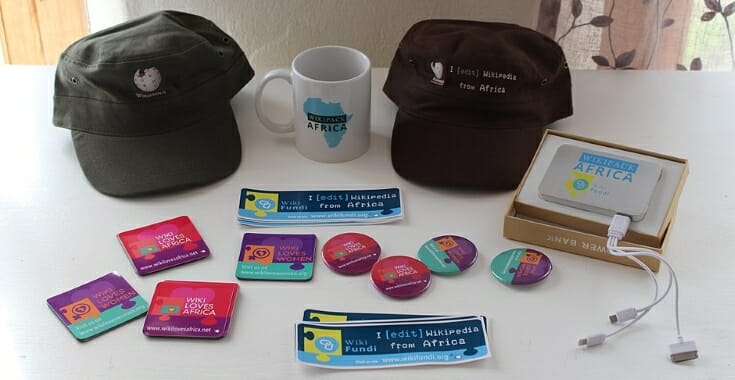By Melissa Chan
Book merchandise, a.k.a. author swag, seems to be one of the latest trends in book promotion. Today, it is our pleasure to welcome Melissa Chan of Literary Book Gifts who explains what to consider and how to go about creating merchandise for our books. I think you’ll find her article an interesting read.
And, if you missed it, you may also want to check out this recently published article by Nate Hoffelder for more information on the subject.
Creating merchandise for your books can be a great way to promote your book while generating income through a new revenue stream.
Selling just a few t-shirts or other products can be extremely lucrative, sometimes making more in profit per sale than the book itself.
The physical nature of merchandise can be daunting. But if you already have a book cover you’re most of the way there.
In this article, I will explain how you can turn your book into sellable merchandise.
Establish your merchandise goals
Before making any decisions, figure out what outcome you want from the project. Without establishing a firm idea of what you are doing you can end up spending a lot of money and time and be disappointed with the result.
Typically there are just two reasons why an author would want to create physical merchandise:
- To sell to your existing fans or followers
- To give it away for free to promote your book
If you are planning on selling to your existing readers you need to create products that they will actually spend money on. This may seem obvious but, think about when the last time was that you spent money on clothing verses a button or other inessential item.
If you plan on going this route you will be more focused towards unique designs that people will want to wear outside and not just during laundry day around the house. The products you offer will be focused towards high quality t-shirts, tote bags, and the occasional backpack.
Everyone likes a freebie. Giving away items at book events and online can be a great way for your fans to promote your book for you in the real world. Since they will be getting it for free the design can be more promotional and should display the title and authors name in large readable text and perhaps a link to the author’s website can be included in the graphic as well.
While it can be a nice idea for every fan to have a free t-shirt, unless you are planning on manufacturing thousands of shirts, the price per shirt is going to be quite steep. In order to be able to give out as many free items as possible you’ll be choosing items such as pins, stickers, and buttons if you are on a budget.
Depending on which direction you want to go, you will make different choices on the type of design you choose, what your budget will be, and which types of products you will choose.
Create a design
Designs printed on merchandise look very similar to book covers and graphics online but are actually quite different in design and in printing.
1. Make the design to capture the novel, not the product
When planning out a successful design it can be tempting to create something new to ‘wow’ your readers. Simply creating a design based of an existing book cover is the best way to go. Making your products a different style than your book cover is an easy way to confuse fans as to what you are selling.
Remember, if your readers wanted a certain style they could easily find it elsewhere. They are here for your book and everything about it that makes it unique so don’t forget to include the title and author somewhere readable on the design.
2. Pay attention to design requirements
There are a few technical details that go into the actual file of the design. Although a design may display well on a screen or in print it may look wrong when printed on a t-shirt or bag.
Take a good look at any graphic t-shirt, you will notice that the ink only covers some parts, and the rest is simply the shirt material. If the shirt has any effects on it such as a distressing to make it look vintage, look closely and you will see that those specks are removed and not simply other colors printed on top.
Graphics must also be large in size so they don’t show up fuzzy in print. Don’t forget to abide by the color space of the printer which is usually CMYK (cyan, magenta, yellow, and key, i.e. black).
The best way to make sure all of your bases are covered is to use a higher level graphics program. GIMP is a free graphics program that allows you to do more complicated graphical editing that cannot be done in a standard word editing program. If you’re low on budget, it is worth spending some time to see if you can achieve the design you want. But remember that even designs that appear simple can require a high level of skill to achieve graphically.
If you already had a professional service create your book cover, you can ask them for pointers, or it’s possible they may be able to make it for you.
Wholesale vs. Print on Demand
It can be very exciting seeing your book live on a t-shirt or even a mousepad, but it is important to make the right decision on how your manufacturing and fulfillment flow will work. Choosing the wrong one could mean you end up with a thousand mugs collecting dust in your garage or making little to no profit on each item.
Which products are you going to offer?
If you will be selling online who is going to ship the items in the mail?
If you choose the wholesale route you will have hundreds if not thousands of items printed at once. This method typically keeps the costs at the lowest per item, but the upfront money can be high. If you already have a large audience that you can predictably sell the merchandise to then this is definitely the way to go and will almost always make the most profit in the end.
In addition you will need to decide who will ship the items in the mail. If you have ever tried to sell a few items online you will know that this is quite a time consuming task. Using a fulfillment service such as Amazon Multichannel Fulfillment can be an option, but it is important to remember a large chunk of your profits can be eaten up by this depending on the prices you charge and the type of merchandise you are shipping.
Print on demand (POD) is a great way to offer a selection of items without any upfront risk. POD means an item is printed only after it is purchased. With a POD services you can offer a t-shirt in all sizes and colors without holding any stock. If you went the wholesale route for this t-shirt you would be looking at 76 individual types of products (4 sizes multiplied by 19 colors).
The negative aspect of POD services is that each item costs a lot to manufacture. But this can be okay because you only pay this fee after someone buys an item. There are a lot of POD services with plenty of different offerings that are changing all the time so shop around a bit for prices and try a few out before making a decision.
Conclusion
Creating merchandise for your product can be an extremely rewarding way to remonetize your existing fan base. Don’t be afraid to experiment with merchandise on a budget and a fulfillment pipeline that works for you.
 Melissa Chan loves bringing books off of their covers and into real life on t-shirts and bags. She designs gifts for book lovers at Literary Book Gifts. Use the promo code THEBOOKDESIGNER20 for 20% off anything in the store. No minimum. Ships to the USA and worldwide.
Melissa Chan loves bringing books off of their covers and into real life on t-shirts and bags. She designs gifts for book lovers at Literary Book Gifts. Use the promo code THEBOOKDESIGNER20 for 20% off anything in the store. No minimum. Ships to the USA and worldwide.
Photo: Wikimedia Commons



